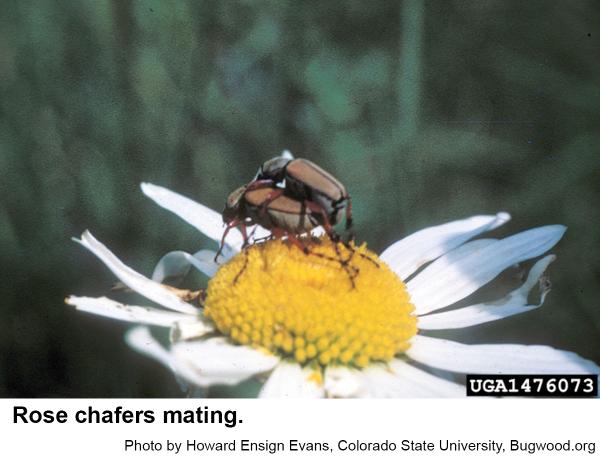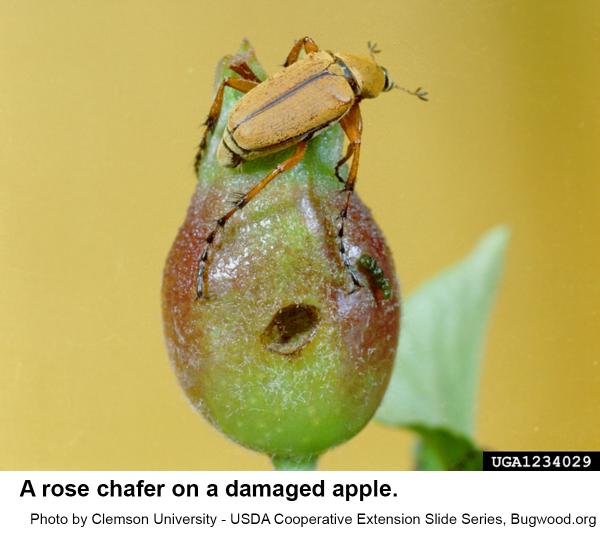Description and Biology
The rose chafer, Macrodactylus subspinosus, is a relatively minor pest of roses that at one time was apparently much more abundant. It is a tan, slender beetle with a reddish head and long, spiny, reddish legs about half an inch long. Females are somewhat more robust than males. The wings do not quite cover the abdomen. This beetle is in a group of beetles called chafers (like the Japanese beetle, spring rose beetle, May beetles, and June beetles) that "chafe" away the upper surface of the leaves and petals as they feed. The rose chafer and Japanese beetle feed during the day, of course, but most others feed at night. The rose chafer tends to fly in late May and early June, about a month earlier than the Japanese beetle. They feed on roses, peonies, and sometimes iris and other flowers. They also feed on grapes and at times may damage elms, birches, and other trees severely. The adults live for about 4 to 6 weeks. Immature rose chafers are white grubs that feed on the roots of pasture grasses and other plants especially in sandy soils. Females lay oval, shiny, tiny white eggs as deep as six inches in sandy soil. The eggs are laid in groups of 6 to 40, but each egg is deposited in a separate cavity. They hatch in a week or three. The larvae eventually grow into slender white grubs about ¾ inch long feeding on the roots of turf and ornamental plants. They apparently move down into the soil for moisture in dry weather. The grubs spend the winter deep in the soil. In early spring the grubs migrate upward, each forms an earthen cell, and they pupate in early May. Mature grubs molt into light yellow-brown pupae that have the last larval skin clinging to the rear. We have one generation per year.
Host Plants
Rose chafers seem to prefer the flowers of roses and peonies, new grapes, and leaves of grapes. They also feed on apple, birch, blackberry, cherry, dahlia, elder, elm, foxglove, geranium, hollyhock, hydrangea, pear, poppy, raspberry, Virginia creeper, and wisteria. Rose chafers are remarkable for the variety of hosts upon which they feed and because they are poisonous to chickens and birds when eaten. Rose chafers consume petals of roses and other flowers and skeletonize the foliage of various broadleaved plants. The grubs feed on the roots of turf, weeds, and nursery stock. Because rose chafers prefer to lay eggs in sandy soil, plants located on sandy sites are likely to be attacked
Residential Recommendations
Rose chafers beetles should be sensitive to Sevin and other insecticides although it is somewhat of a "Catch 22" because folks really should not treat open blossoms with Sevin because Sevin is harmful to honey bees and other wild bees. Roses can be protected by stretching cheese cloth or some other fabric around the shrubs and a little higher than the shrubs while the beetles are in flight (most of June). For some reason, rose chafers do not fly over and drop down into the roses, they have to fly in from the side! Handpicking the beetles and dropping them into soapy water may help. Rose chafers apparently they contain cantharidin, a blistering agent, and should not be fed to poultry or family pets. Foliage being attacked by rose chafers can be protected by any one of the pyrethroids labeled for landscape use by homeowners. When used as directed, pyrethroids are very toxic to insects but are not particularly hazardous to humans and pets (other than fish-avoid using pyrethroids around pools, ponds, and streams). These insecticides are readily available in most garden centers.
References
- Insect and Related Pests of Shrubs. Baker, J. R. ed. 1980. NC Agr. Extension Service pub. AG-189. 199 pp.
- Rose Chafers. Hahn, J. 2007. University of Minnesota Extension, Insects.
- Rose Chafer (Macrodactylus subspinosus). Staff Writer. 2019. Insect Identification for the Casual Observer.
- Extension Plant Pathology Publications and Factsheets
- Horticultural Science Publications
- North Carolina Agricultural Chemicals Manual
For assistance with a specific problem, contact your local Cooperative Extension Center.
This Factsheet has not been peer reviewed.
Publication date: June 7, 2016
Reviewed/Revised: Oct. 11, 2019
Recommendations for the use of agricultural chemicals are included in this publication as a convenience to the reader. The use of brand names and any mention or listing of commercial products or services in this publication does not imply endorsement by NC State University or N.C. A&T State University nor discrimination against similar products or services not mentioned. Individuals who use agricultural chemicals are responsible for ensuring that the intended use complies with current regulations and conforms to the product label. Be sure to obtain current information about usage regulations and examine a current product label before applying any chemical. For assistance, contact your local N.C. Cooperative Extension county center.
N.C. Cooperative Extension prohibits discrimination and harassment regardless of age, color, disability, family and marital status, gender identity, national origin, political beliefs, race, religion, sex (including pregnancy), sexual orientation and veteran status.



